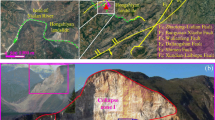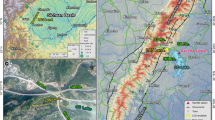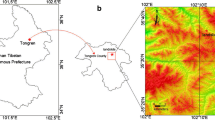Abstract
On June 1, 2022, at 17:00, an Ms 6.1 earthquake occurred in Lushan County, Ya’an City, Sichuan Province (30.37°N, 102.94°E), followed by an Ms 4.5 earthquake at 17:03 in Baoxing County, Ya’an City (30.37°N, 102.92°E). These two earthquakes were superimposed on continuous rainfall that began on May 6, 2022, inducing instability in the upper part of the reinforced section at the exit of the Xinhua Village Tunnel, resulting in a large high-altitude landslide. The landslide deposited material around 280 m upstream of the Baoxing Power Station dam, forming a barrier lake and causing the water level in the reservoir to rise by about 5 m. The accumulated material in the river channel is estimated to be about 200,000 m3. The residual landslide buried the tunnel exit and the National Road G351 foundation outside the tunnel, with an estimated volume of about 560,000 m3 and a maximum burial depth of 58 m. The landslide closed the G351 Xinhua Village Tunnel, affecting the operation of this important transportation corridor on the eastern edge of the Qinghai–Tibet Plateau. This research summarizes the development of the Xinhua Village landslide over the past decade under the influences of multiple earthquakes, rainfall, and heavy snow. Our research presents a preliminary investigation of the failure and kinematic characteristics of this landslide based on a field survey, unmanned aerial vehicle (UAV) photogrammetry, and 3D-MPM numerical simulation. These methods provide more detailed information about the movement of the landslide than traditional field investigation.


















Similar content being viewed by others
References
Cui P, Chen XQ, Zhu YY et al (2011) The Wenchuan earthquake (May 12, 2008), Sichuan Province, China, and resulting geohazards. Nat Hazards 56(1):19–36
Du WJ, Sheng Q, Fu XD et al (2021) Extensions of the two-phase double-point material point method to simulate the landslide-induced surge process. Eng Anal Bound Elem 133(12):362–375
Du WJ, Sheng Q, Fu XD et al (2022) A TPDP-MPM-based approach to understanding the evolution mechanism of landslide-induced disaster chain. J Rock Mech Geotech 14(4):1200–1209
Du WJ, Sheng Q, Fu XD et al (2023) Post-failure analysis of landslide blocking river using the two-phase double-point material point method: a case of western Hubei. China Bull Eng Geol Environ 82:98
Fan XM, Scaringi G, Korup O et al (2019) Earthquake-induced chains of geologic hazards: patterns, mechanisms, and impacts. Rev Geophys 2:57
Fu XD, Sheng Q, Li G et al (2020) Analysis of landslide stability under seismic action and subsequent rainfall: a case study on the Ganjiazhai giant landslide along the Zhaotong-Qiaojia road during the 2014 Ludian earthquake, Yunnan, China. Bull Eng Geol Environ 79:5229–5248
Huang RQ, Li WL (2014) Post-earthquake landsliding and long-term impacts in the Wenchuan earthquake area, China. Eng Geol 182:111–120
Keefer DK (1994) The importance of earthquake-induced landslides to long-term slope erosion and slope-failure hazards in seismically active regions. Geomorphology 10:265–284
Lax PD, Wendroff B (1962) The Courant-Friedrichs-Lewy (CFL) condition. Commun Pure Appl Math 15(4):363–371
Martino S, Antonielli B, Bozzano F et al (2020) Landslides triggered after the 16 August 2018 Mw 5.1 Molise earthquake (Italy) by a combination of intense rainfalls and seismic shaking. Landslides 17(5):1177–1190
Nakamura H, Tsuchiya S, Inoue K et al (2000) Sabo against earthquakes. Kokon Shoin, Tokyo, pp 190–220
Sassa K, Fukuoka H, Wang FW et al (2007) Landslides industry by a combined effect of earthquake and rainfall. Progress in Landslide Science, Berlin Heidelberg, pp 193–207
Septian A, Llano-Serna MA, Ruest MR et al (2017) Three-dimensional kinematic analysis of Bingham canyon mine pit wall slides. Procedia Eng 175:86–93
Tang C, Zhu J, Qi X et al (2011) Landslides induced by the Wenchuan earthquake and the subsequent strong rainfall event: a case study in the Beichuan area of China. Eng Geol 122:22–33
Tuladhar GR, Tiwari B, Marui H (2007) Post earthquake evaluation of Higashi Takezawa Landslide located at Niigata Prefecture of Japan. Proceedings of Sessions of Geo-Denver
Xu XR, Jin F, Sun QC et al (2018) Three-dimensional material point method modeling of the runout behavior of the Hongshiyan Landslide. Can Geotech J 56
Yang CM, Lee CH, Liu CY et al (2022) Assessing the impact of rockfall on the retaining structures of a mountain road: a case study in Taiwan. Landslides 19:2737–2746
Funding
The work reported in this paper is financially supported by the Youth Innovation Promotion Association CAS (NO.2021325) and the National Natural Science Foundation of China (No. 52179117; No. U21A20159). A special acknowledgement should be expressed to China-Pakistan Joint Research Center on Earth Sciences that supported the implementation of this study.
Author information
Authors and Affiliations
Corresponding author
Ethics declarations
Conflict of interest
The authors declare no competing interests.
Rights and permissions
Springer Nature or its licensor (e.g. a society or other partner) holds exclusive rights to this article under a publishing agreement with the author(s) or other rightsholder(s); author self-archiving of the accepted manuscript version of this article is solely governed by the terms of such publishing agreement and applicable law.
About this article
Cite this article
Du, W., Wu, K., Fu, X. et al. Failure history, mechanism, and recent run-out reproduction of the Xinhua Village landslide triggered by the 2022 Ms 6.1 Lushan earthquake. Landslides 20, 2675–2693 (2023). https://doi.org/10.1007/s10346-023-02148-x
Received:
Accepted:
Published:
Issue Date:
DOI: https://doi.org/10.1007/s10346-023-02148-x




